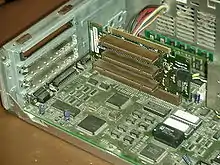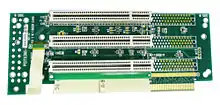Riser card
A riser card is a printed circuit board that picks up a multitude of signal lines (often bused) via a single connector (usually an edge connector) on a motherboard and distributes them via dedicated connectors on the card.

Riser cards are often used to allow adding expansion cards to a system enclosed in a low-profile case where the height of the case does not allow for a perpendicular placement of the full-height expansion card.
A riser card is a board that plugs into the system board and provides additional slots for adapter cards. Because it rises above the system board, it enables you to connect additional adapters to the system in an orientation that is parallel to the system board and save space within the system case.
Applications


Riser cards are used in rack-mount server and industrial computer applications. In 1U and 2U rack-mount computer systems, riser cards are integrated into the system to allow the addition of feature cards in a horizontal position (instead of a standard vertical position). This is due to the height limitations of a 1U and 2U system which are 1.75" and 3.5" respectively. Typically, a 1U system uses a 1U single slot riser card whereas a 2U system uses a 2U 3 slot riser card. Nowadays riser cards are often used by miners, for mining crypto-coins. These riser cards extended by USB-cable, are used to place GPU mining-cards in a so called mining-rack.